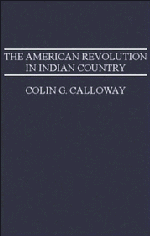Book contents
- Frontmatter
- Dedication
- Contents
- List of figures and maps
- Preface
- Acknowledgments
- Abbreviations
- Prologue New worlds for all: Indian America by 1775
- 1 Corn wars and civil wars: the American Revolution comes to Indian country
- 2 Odanak: Abenaki ambiguity in the North
- 3 Stockbridge: the New England patriots
- 4 Oquaga: dissension and destruction on the Susquehanna
- 5 Fort Niagara: the politics of hunger in a refugee community
- 6 Maquachake: the perils of neutrality in the Ohio country
- 7 Chota: Cherokee beloved town in a world at war
- 8 Tchoukafala: the continuing Chickasaw struggle for independence
- 9 Cuscowilla: Seminole loyalism and Seminole genesis
- 10 The peace that brought no peace
- Epilogue A world without Indians?
- Index
8 - Tchoukafala: the continuing Chickasaw struggle for independence
Published online by Cambridge University Press: 18 December 2014
- Frontmatter
- Dedication
- Contents
- List of figures and maps
- Preface
- Acknowledgments
- Abbreviations
- Prologue New worlds for all: Indian America by 1775
- 1 Corn wars and civil wars: the American Revolution comes to Indian country
- 2 Odanak: Abenaki ambiguity in the North
- 3 Stockbridge: the New England patriots
- 4 Oquaga: dissension and destruction on the Susquehanna
- 5 Fort Niagara: the politics of hunger in a refugee community
- 6 Maquachake: the perils of neutrality in the Ohio country
- 7 Chota: Cherokee beloved town in a world at war
- 8 Tchoukafala: the continuing Chickasaw struggle for independence
- 9 Cuscowilla: Seminole loyalism and Seminole genesis
- 10 The peace that brought no peace
- Epilogue A world without Indians?
- Index
Summary
By the time of the American Revolution, the Chickasaw Indians were already veterans in their own struggles to preserve their independence. Located in northern Mississippi and western Tennessee in a strategic area between the Yazoo and Tombigbee rivers, with powerful Indian nations as neighbors and ambitious European nations as suitors and enemies, the Chickasaws offset their numerical weakness with skilled diplomacy and military prowess. They fought against De Soto's Spaniards in 1540–1, resisted French and Choctaw assaults in the eighteenth century, and maintained their place in the swirling world of Spanish, French, English, and tribal war, trade, and diplomacy. The Revolution in Chickasaw country was a small affair in terms of fighting, but it significantly changed the Chickasaws' diplomatic landscape. They responded to the new competition between Spain and the United States in much the same way as they had dealt with the old competition between France and England. Factions formed, but the Chickasaws' common and consistent goal, in the words of Piomingo, chief of Tchoukafala for more than a decade after the Revolution, was to preserve their independence as a “people to our Selves.” In time, however, American independence and expansion delivered a body blow to Chickasaw independence.
Chickasaw traditions, as handed down at the time of the Revolution, remembered that they were “only a family from a great rich nation towards the sun setting,” who had migrated east after their fathers dreamed “that away towards the sun rising was land of life.” Compared to their Choctaw neighbors, the Chickasaws were a small nation. They said they had ten thousand warriors when they first came from the west, but chronic warfare steadily reduced the population. The Chickasaws bolstered their population by adopting captives, absorbing small neighboring tribes, and accommodating Natchez refugees after the French destroyed that nation in 1730. A French report in 1731 estimated the Chickasaws at six hundred men, roughly three thousand people, plus “250 or 300 Natchez who have joined them.”
- Type
- Chapter
- Information
- The American Revolution in Indian CountryCrisis and Diversity in Native American Communities, pp. 213 - 243Publisher: Cambridge University PressPrint publication year: 1995



